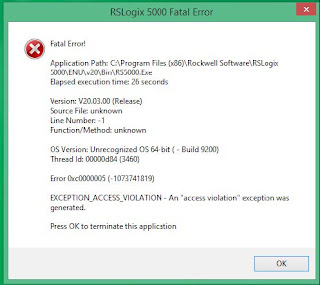ControlLogix Processor Basics
Introduction to the ControlLogix Processor
The processor is the controller of an automation system. This is where the program is stored that automates industrial systems. Although ControlLogix processor can be placed in any slot of the chassis, it is traditionally placed in Slot 0. The processor is programmed using RSLogix 5000 (renamed to Studio 5000 in version 21).
The L6x processor has a serial port on board which can be used to communicate with a laptop, panelview terminal, or other devices which commonly use the DF1 protocol, or ASCII for communication. The L7x processors have a USB port for communication.
The battery retains the memory when the processor is powered down. When replacing the battery, be sure the processor is powered up, or the program will be lost. In some cases, the entire panel must be powered down to open a cabinet to access the processor. If this is the case, be sure you have a backup of your ControlLogix project before replacing the battery in a processor that is powered down. You will loose the program, and have to download the project again using RSLogix/Studio 5000. On the L7x and L8x processors, you will notice an “Energy Storage” feature. This is a capacitor that will eliminate the need for a battery in most cases.
Status Indicators
1756-L6x
RUN: If the run light is solid green, the processor is running the program. If the Run light is not illuminated, the processor may be in program mode, or powered off.
FORCE: Forcing simulates field jumpers (to some extent). If the Force light is flashing amber, forces are installed but not enabled. A solid amber force light indicates that forces are enabled in the processor.
BAT: This indicator will be solid red if the battery is low or missing. Be sure to replace the battery as soon as possible if this indicator is on. Be aware that in some systems, a battery is not desired.
I/O: The I/O light is normally solid green in a running system. If the I/O light is not illuminated, the processor is not trying to connect to any I/O in your system. If the I/O light is flashing green, then you have a problem with at least one I/O Module. Go online with the processor in Studio 5000. In the Controller Organizer window on the left side of your screen, scroll down to the I/O Configuration tree. A caution icon will be on the module you are having a problem with. Right click the module, and go to the properties. The connection tab will give you a description of the problem.
RS232: This indicator will flicker or flash as data is being transferred across the serial port.
OK: The OK light should normally be solid green. A solid red OK light will usually indicate a hardware issue. You can try to cycle power, or re-seat the processor, but if it’s a critical system, I would recommend replacing the processor. If the OK light is flashing red, then a software fault has occurred. To get a description of the fault, go online with the processor using Studio 5000. In the online toolbar (usually at the top left of your window), you will see that the processor is faulted. Hit your pull down tab, and select “Go to Faults”, or “Go to Error”. This will give you a description of the fault.
1756-L7x
SD: This indicator will flash or solid green as SD card is being reading or writing. Flashing or solid red indicates SD card does not have valid file system or not recognized. Do not remove SD card while in use.
RUN, FORCE and OK are same as previous series.
1756-L8x
L8x series actually look pretty similar to L7x series, with additional EtherNet/IP port built to the processor.
NET: Solid green when it is normally in use. Flashing green could be controller having a valid IP address setting but no active connection established. While duplicate IP address or invalid configuration will result in solid red. If the controller is not configured or the prot is disabled, the indicator will stay off.
LINK: Flashing green when activity exist on the port.
RUN, FORCE and OK are same as previous series.
Note: L7x or L8x series processor comes with AlphaNumeric data display for diagnostics information.
Keyswitch
If the Keyswitch is locked into RUN mode, you cannot create tags, download to the processor, or modify logic. The value of existing tags can be changed. If the keyswitch is locked into PROG (program) mode, the processor’s program is not running. If the keyswitch is in REM (remote) mode, then you can perform online edits, change the mode of the processor from your PC, and download to the processor. Be aware that if you download to your processor, your system will likely shut down.
Replacing the Processor
The procedure for replacing the processor will vary between different locations. In general, though, to replace a processor, be sure you have the latest backup of the Studio 5000 project. Next, replace the processor, and be sure the battery is connected on the new processor if applicable. Open your project in Studio 5000 (this will have a .ACD extension). Be sure your communication path is set up correctly. You can build the path under Communication, Who Active on the menu bar. Then select Download. Most likely, you will want to be communicating of USB or Ethernet as the DF1 Serial connection on the L63x processors and earlier is very slow. Now, Studio 5000 will ask to flash the processor with the project revision. Then the download will take place. Flashing the processor over DF1 may take a couple hours! Ethernet will just take a few minutes.
If the processor’s clock is not set by a server, you will also want to set the clock manually. Go to Controller Properties. Then in the online toolbar, this is the icon beneath your keyswitch, or right click the controller in the I/O tree and select Properties. Next, set the clock on the Date/Time tab while you are online with the processor.






Comments
Post a Comment